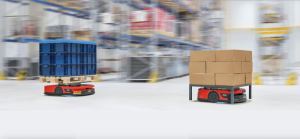As you consider modernizing your warehouse operations, you’re likely weighing the potential return on investment of mobile robots. It’s a decision that shouldn’t be taken lightly, given the substantial upfront costs and the promise of long-term benefits. While the initial figures might seem formidable, the true value lies in the nuanced improvements to productivity, labor efficiency, and safety. But how do you accurately calculate these benefits, and what factors should you consider beyond the obvious? The answer isn’t straightforward, but understanding the full scope of ROI can make the difference between a smart investment and a costly misstep.
decision that shouldn’t be taken lightly, given the substantial upfront costs and the promise of long-term benefits. While the initial figures might seem formidable, the true value lies in the nuanced improvements to productivity, labor efficiency, and safety. But how do you accurately calculate these benefits, and what factors should you consider beyond the obvious? The answer isn’t straightforward, but understanding the full scope of ROI can make the difference between a smart investment and a costly misstep.
Understanding Mobile Robot Costs
Calculating the total cost of mobile robots requires a comprehensive analysis of both upfront and ongoing expenses. You’ll need to evaluate initial hardware costs, typically ranging from $25,000 to $100,000 per unit, depending on complexity. Factor in software licensing fees, installation costs, and integration expenses. Don’t forget ongoing maintenance, repairs, software updates, and energy consumption. These operational costs can add 10-20% annually to your initial investment.
Quantifying Productivity Gains
How can you measure the impact of mobile robots on warehouse productivity? Analyze key performance indicators (KPIs) such as:
1. Order fulfillment rate
2. Picking accuracy
3. Inventory turnover
4. Labor hours per order
5. Throughput (units processed per hour)
Compare pre-implementation baselines with post-implementation data. Track these metrics over time to quantify improvements. Calculate percentage increases in efficiency and reductions in errors. Assess the impact on overall operational costs and revenue generation.
Labor Savings and Reallocation
Mobile robots can dramatically reduce labor costs in warehouse operations. You’ll typically see a 50-70% reduction in labor hours for picking tasks. This allows you to reallocate workers to higher-value activities or reduce headcount. Calculate potential savings by multiplying reduced labor hours by average hourly wage. Factor in benefits and overtime costs for a comprehensive analysis of labor-related ROI from robotic implementation.
Safety and Accuracy Improvements
Beyond labor savings, safety and accuracy improvements contribute significantly to the ROI of mobile robots in warehouse automation. You’ll see a 50-70% reduction in workplace accidents with automated systems. Order accuracy typically increases from 96% to 99.9%, reducing costly returns and enhancing customer satisfaction. Robotic systems can operate 24/7 without fatigue, maintaining consistent performance levels and minimizing human error-related losses by up to 80%.
